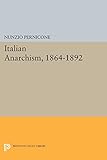Italian Anarchism, 1864-1892 / Nunzio Pernicone.
Material type: TextSeries: Princeton Legacy Library ; 271Publisher: Princeton, NJ : Princeton University Press, [2014]Copyright date: ©1993Edition: Course BookDescription: 1 online resource (342 p.) : 6 halftonesContent type:
TextSeries: Princeton Legacy Library ; 271Publisher: Princeton, NJ : Princeton University Press, [2014]Copyright date: ©1993Edition: Course BookDescription: 1 online resource (342 p.) : 6 halftonesContent type: - 9780691603339
- 9781400863501
- 335.83094509
- HX902 -- P47 1993eb
- online - DeGruyter
- Issued also in print.
| Item type | Current library | Call number | URL | Status | Notes | Barcode | |
|---|---|---|---|---|---|---|---|
 eBook
eBook
|
Biblioteca "Angelicum" Pont. Univ. S.Tommaso d'Aquino Nuvola online | online - DeGruyter (Browse shelf(Opens below)) | Online access | Not for loan (Accesso limitato) | Accesso per gli utenti autorizzati / Access for authorized users | (dgr)9781400863501 |
Frontmatter -- CONTENTS -- List of Illustrations -- Acknowledgments -- Abbreviations -- Introduction -- PART ONE: Bakunin and the Origins of Italian Anarchism -- CHAPTER ONE. Bakunin and the Italians, 1864-1870 -- CHAPTER TWO. The Rise of the International in Italy, 1870-1872 -- PART TWO: The Italian International -- CHAPTER THREE. The Italian Federation of the IWA, 1872-1874 -- CHAPTER FOUR. Insurrection and Repression, 1874-1876 -- CHAPTER FIVE. Resurgence and Insurrection, 1876-1877 -- CHAPTER SIX. The Twilight of the Italian International, 1877-1878 -- CHAPTER SEVEN. The Suppression of the Italian International, 1878-1880 -- PART THREE: Crisis, Transformation, and Decline -- CHAPTER EIGHT. The Defection of Andrea Costa, 1879-1882 -- CHAPTER NINE. Crisis and Metamorphosis, 1879-1883 -- CHAPTER TEN. Struggling to Survive, 1883-1885 -- CHAPTER ELEVEN. Too Little, Too Late, 1885-1890 -- CHAPTER TWELVE. Malatesta and Resurgence, 1889-1891 -- CHAPTER THIRTEEN. Descent into Isolation, 1891-1892 -- Epilogue: 1892-1900 -- Bibliography -- Index
restricted access online access with authorization star
http://purl.org/coar/access_right/c_16ec
Historians have frequently portrayed Italian anarchism as a marginal social movement that was doomed to succumb to its own ideological contradictions once Italian society modernized. Challenging such conventional interpretations, Nunzio Pernicone provides a sympathetic but critical treatment of Italian anarchism that traces the movement's rise, transformation, and decline from 1864 to 1892. Based on original archival research, his book depicts the anarchists as unique and fascinating revolutionaries who were an important component of the Italian socialist left throughout the nineteenth century and beyond.Anarchism in Italy arose under the influence of the Russian revolutionary Bakunin, triumphed over Marxism as the dominant form of early Italian socialism, and supplanted Mazzinianism as Italy's revolutionary vanguard. After forming a national federation of the Anti-Authoritarian International in 1872, the Italian anarchists attempted several insurrections, but their organization was suppressed. By the 1880s the movement had become atomized, ideologically extreme, and increasingly isolated from the masses. Its foremost leader, Errico Malatesta, attempted repeatedly to revitalize the anarchists as a revolutionary force, but internal dissension and government repression stifled every resurgence and plunged the movement into decline. Even after their exclusion from the Italian Socialist Party in 1892, the anarchists remained an intermittently active and influential element on the Italian socialist left. As such, they continued to be feared and persecuted by every Italian government.Originally published in 1993.The Princeton Legacy Library uses the latest print-on-demand technology to again make available previously out-of-print books from the distinguished backlist of Princeton University Press. These editions preserve the original texts of these important books while presenting them in durable paperback and hardcover editions. The goal of the Princeton Legacy Library is to vastly increase access to the rich scholarly heritage found in the thousands of books published by Princeton University Press since its founding in 1905.
Issued also in print.
Mode of access: Internet via World Wide Web.
In English.
Description based on online resource; title from PDF title page (publisher's Web site, viewed 30. Aug 2021)


